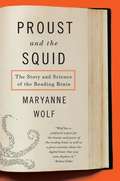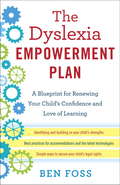Title search results
Showing 1 - 4 of 4 items

The dyslexic advantage: unlocking the hidden potential of the dyslexic brain
By Brock L. Eide, Fernette F. Eide, Brock Eide. 2011
DAISY audio (Direct to player), DAISY audio (Zip)
Disabilities, General non-fiction, Health and medicine, Psychology, Self help, Medicine
Human-narrated audio
Scientists reveal the benefits of having a dyslexic brain--one that has a unique pattern of organization and information processing. They…
employ the MIND model to detail the strengths in material, interconnected, narrative, and dynamic reasoning in dyslexics and to discuss ways assistive technology can put those strengths to use. 2011
Proust and the squid: the story and science of the reading brain
By Maryanne Wolf. 2008
DAISY audio (Direct to player), DAISY audio (Zip)
Science and technology, General non-fiction, Medicine, Psychology
Human-narrated audio
Discusses the evolution of our human brain's capacity to learn to read. Begins with the origins of writing, proceeds to…
the development of the reading brain and its pathways to acquisition, and ends with questions about potential transformations due to digital technology. Examines reading difficulties of children with dyslexia. 2007
Overcoming Dyslexia: Second Edition, Completely Revised and Updated
By Sally E. Shaywitz, Jonathan Shaywitz. 2011
Braille (Contracted), Electronic braille (Contracted), DAISY Audio (Direct to Player), DAISY Audio (Zip), DAISY text (Direct to player), DAISY text (Zip), Word (Zip), ePub (Zip)
General non-fiction, Disabilities, Psychology
Synthetic audio, Automated braille
A major update and revision of the essential program for reading problems at any level, incorporating the latest breakthroughs in…
science, educational methods, technology and legal accommodations. 'Sally Shaywitz is an amazing woman... no one has a better understanding of dyslexia' - Bob DylanDyslexia is the most common learning disorder in the world, affecting one in five individuals. Now Drs Sally and Jonathan Shaywitz give us a substantially updated and augmented edition of her classic work, Overcoming Dyslexia, drawing on an additional fifteen years of ground-breaking scientific research to offer new information on both the big picture and the specific details of dyslexia and reading problems, and providing the tools that parents, teachers and dyslexic individuals of any age need. This updated edition offers:* New chapters on the latest science-based diagnosis of dyslexia, identifying the at-risk child, dyslexia in post-menopausal women, and implications of associated anxiety and ADHD in dyslexia* State-of-the-art information on universal screening for dyslexia as early as the first year of school - why and how to efficiently and effectively screen young children* An expanded chapter on choosing the best school for a dyslexic child and new chapters examining exciting innovative school models* New chapters focused on higher education, including preparing a dyslexic for university, choosing a university or higher education course for a dyslexic student and making the university experience work* The latest advances in digital technology that increase a dyslexic's ability to help him or herself* Extensively updated material on helping dyslexic individuals of all ages become better readers, with detailed home programs to enhance reading at different ages and levels* How to use compassion and exciting new knowledge to build and strengthen a child's self-esteem and resilience * Insightful stories of outstanding men, women and young adults who are dyslexic and thriving and how they succeeded. Acclaimed by experts and parents alike, Overcoming Dyslexia provides anyone who is struggling with reading problems with the necessary reassurance that, through hard work and the right help, such difficulties can be overcome.
The Dyslexia Empowerment Plan
By Ben Foss. 2013
Braille (Contracted), Electronic braille (Contracted), DAISY Audio (Direct to Player), DAISY Audio (Zip), DAISY text (Direct to player), DAISY text (Zip), Word (Zip), ePub (Zip)
General non-fiction, Disabilities, Parenting
Synthetic audio, Automated braille
Finally, a groundbreaking book that reveals what your dyslexic child is experiencing--and what you can do so that he or…
she will thrive. More than thirty million people in the United States are dyslexic--a brain-based genetic trait, often labeled as a "learning disability" or "learning difference," that makes interpreting text and reading difficult. Yet even though children with dyslexia may have trouble reading, they don't have any problems learning; dyslexia has nothing to do with a lack of intellect. While other books tell you what dyslexia is, this book tells you what to do. Dyslexics' innate skills, which may include verbal, social, spatial, kinesthetic, visual, mathematical, or musical abilities, are their unique key to acquiring knowledge. Figuring out where their individual strengths lie, and then harnessing these skills, offers an entrée into learning and excelling. And by keeping the focus on learning, not on standard reading the same way everyone else does, a child with dyslexia can and will develop the self-confidence to flourish in the classroom and beyond. After years of battling with a school system that did not understand his dyslexia and the shame that accompanied it, renowned activist and entrepreneur Ben Foss is not only open about his dyslexia, he is proud of it. In The Dyslexia Empowerment Plan he shares his personal triumphs and failures so that you can learn from his experiences, and provides a three-step approach for success: Identify your child's profile: By mapping your child's strengths and weaknesses and assisting her to better understand who she is, you can help your child move away from shame and feelings of inadequacy and move toward creating a powerful program for learning. Help your child help himself: Coach your child to become his own best advocate by developing resiliency, confidence, and self-awareness, and focusing on achievable goals in areas that matter most to him. Create community: Dyslexic children are not broken, but too often the system designed to educate them is. Dare to change your school so that your child has the resources to thrive. Understanding your rights and finding allies will make you and your child feel connected and no longer alone. Packed with practical ideas and strategies dyslexic children need for excelling in school and in life, this empowering guide provides the framework for charting a future for your child that is bright with hope and unlimited potential.